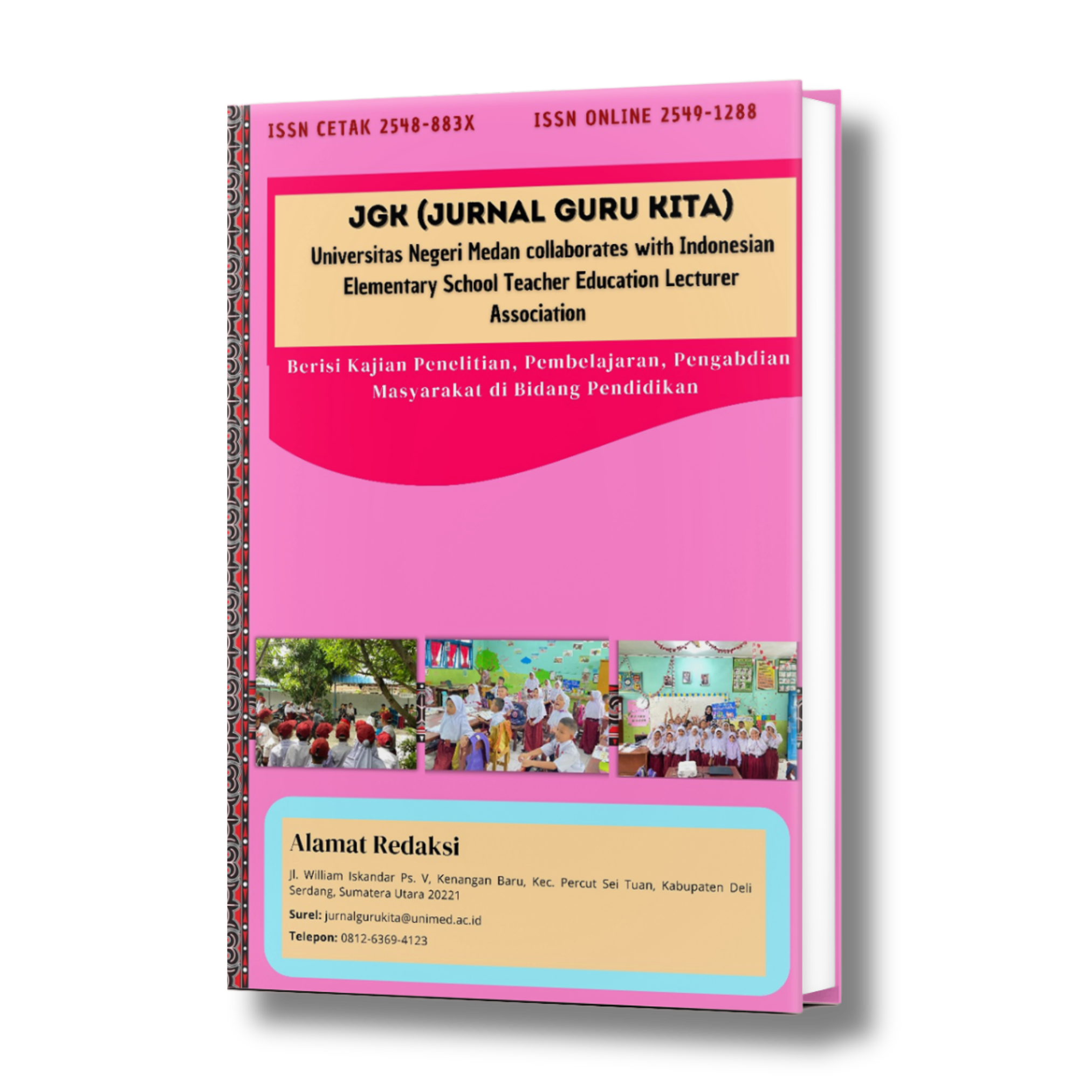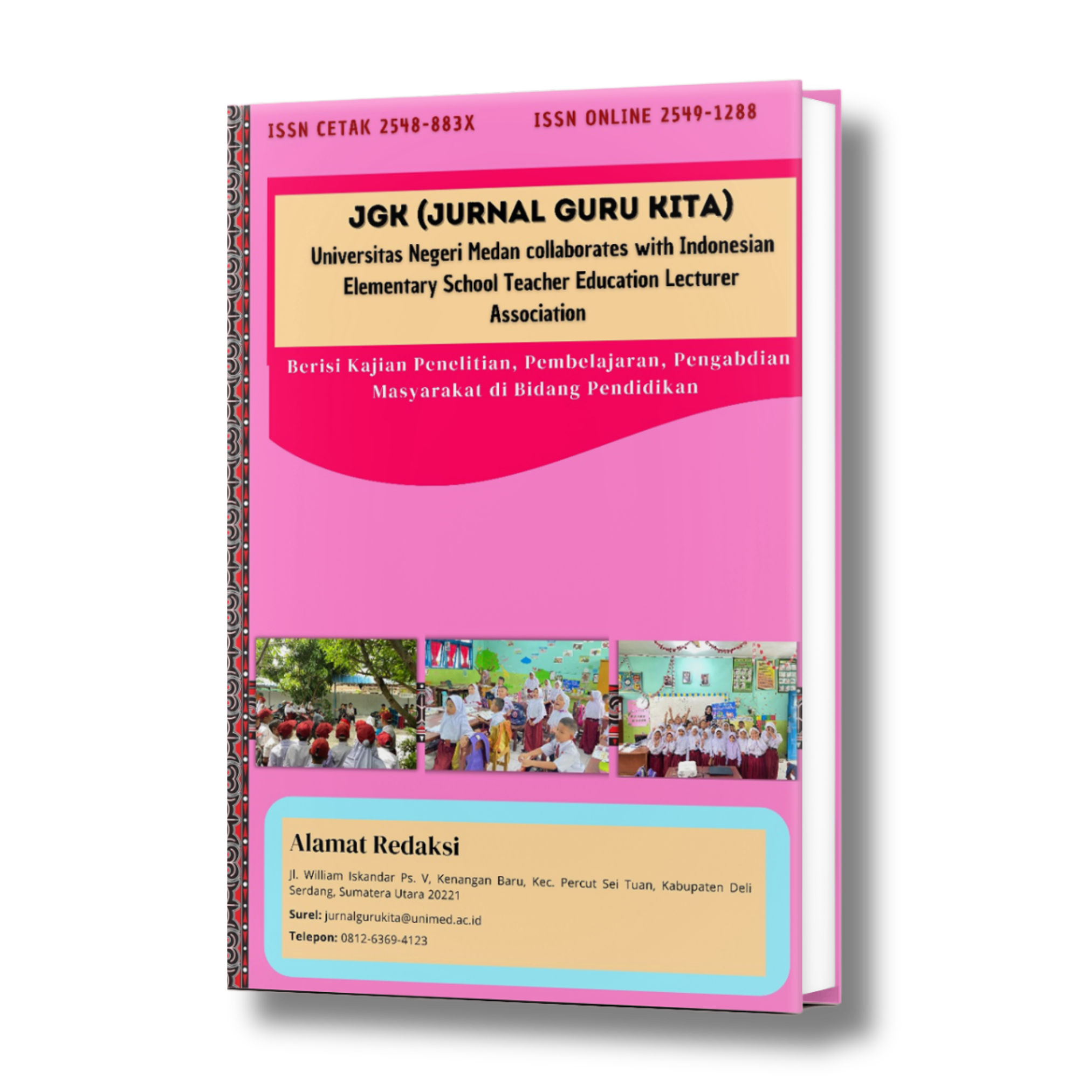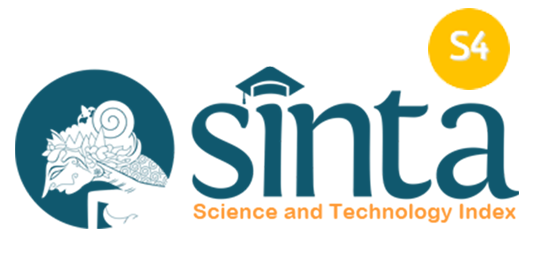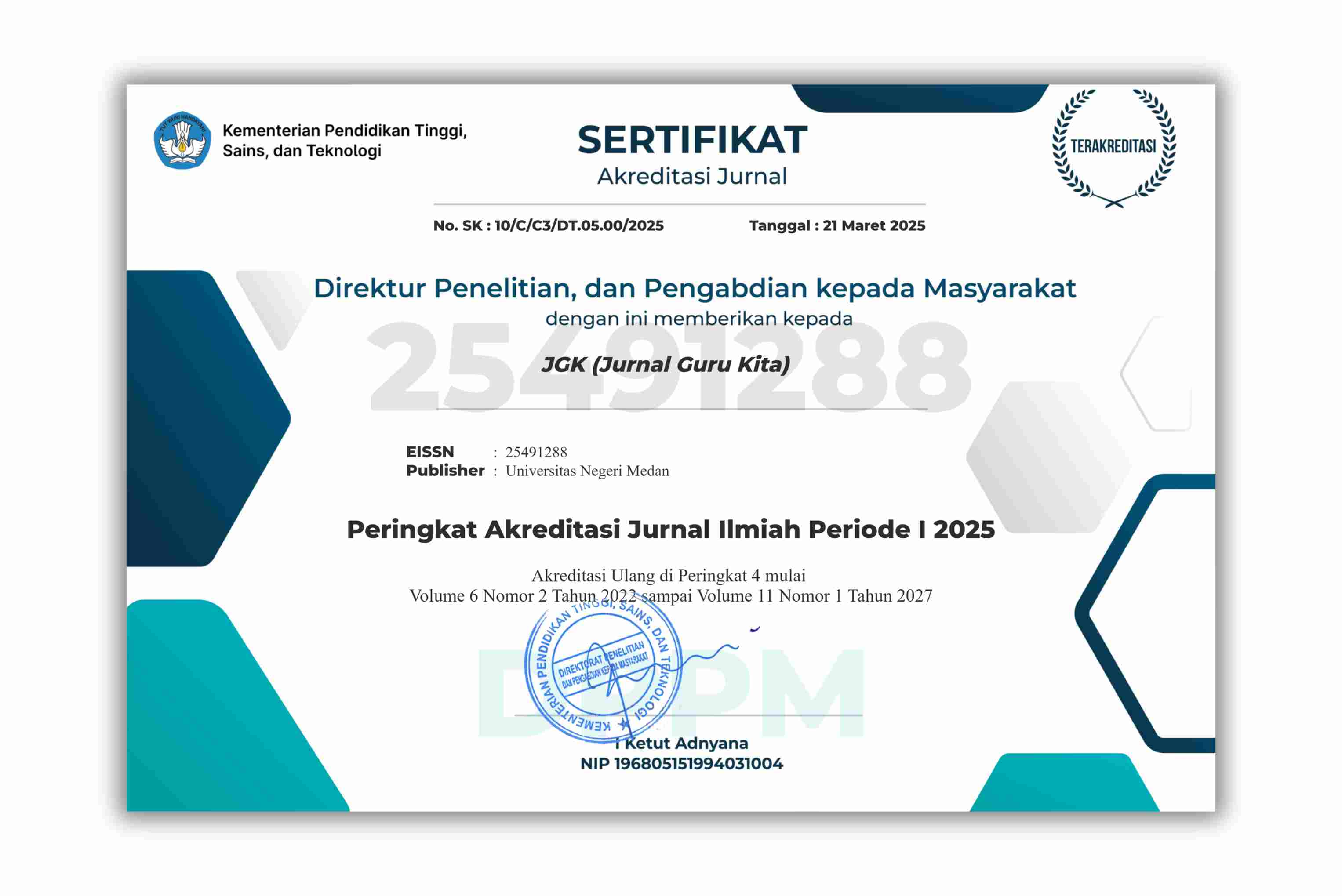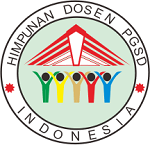Perbandingan Penggunaan Media Book Up Konkret dan Digital Terhadap Minat Belajar Siswa di SDN Barelantan
DOI:
https://doi.org/10.24114/jgk.v9i4.69482Keywords:
Media Pembelajaran, Book Up Konkret, Media Digital, Minat Belajar, Siswa Sekolah DasarAbstract
Penelitian ini bertujuan untuk membandingkan pengaruh penggunaan media book up konkret (pop-up book) dan media digital interaktif terhadap minat belajar siswa kelas IV di SD Negeri Barelantan. Latar belakang penelitian ini berangkat dari permasalahan rendahnya minat siswa dalam kegiatan membaca awal, yang berdampak pada kurangnya keterlibatan dan antusiasme mereka dalam pembelajaran. Penelitian menggunakan pendekatan kuantitatif dengan desain eksperimen semu, melibatkan dua kelompok eksperimen yang masing-masing terdiri dari 20 siswa. Instrumen yang digunakan meliputi angket minat belajar, observasi aktivitas siswa, dan dokumentasi. Hasil analisis menunjukkan bahwa kedua media memberikan pengaruh terhadap peningkatan minat belajar, tetapi media book up konkret menunjukkan peningkatan yang lebih signifikan dibandingkan media digital. Nilai uji-t sebesar 4,23 dengan signifikansi 0,024 (p < 0,05) menegaskan adanya perbedaan yang bermakna antar kelompok. Temuan ini memperkuat bahwa media pembelajaran konkret yang melibatkan visualisasi tiga dimensi mampu merangsang perhatian dan partisipasi siswa secara lebih efektif, terutama pada tahap awal pembelajaran membaca.References
Achjar, K. A. H., Rusliyadi, M., Zaenurrosyid, A., Rumata, N. A., Nirwana, I., & Abadi, A. (2023). Metode Penelitian Kualitatif: Panduan Praktis untuk Analisis Data Kualitatif dan Studi Kasus. PT. Sonpedia Publishing Indonesia.
Aida, N. A., Rahman, A. Y., Saefuddin, A., & Widowati, K. (2025). Developing a Pop-Up Book to Enhance Indonesian Narrative Text Comprehension for Fourth-Grade Elementary School Students. Journal of Integrated Elementary Education, 5(2), 369–390. https://doi.org/10.21580/jieed.v5i2.26402
Aini, I. F. N., Nuraini, N. L. S., & Yuniawatika, Y. (2023). Development of pop-up book media based on project-based learning in mathematics learning about flat shapes in elementary schools. JINoP (Jurnal Inovasi Pembelajaran), 9(2), 259–276. https://doi.org/10.22219/jinop.v9i2.28299
AlAfnan, M. A., & Dishari, S. (2024). ESD goals and soft skills competencies through constructivist approaches to teaching: an integrative review. Journal of Education and Learning (EduLearn), 18(3), 708–718. https://doi.org/10.11591/edulearn.v18i3.21408
Alam, A., & Mohanty, A. (2023). Cultural beliefs and equity in educational institutions: exploring the social and philosophical notions of ability groupings in teaching and learning of mathematics. International Journal of Adolescence and Youth, 28(1). https://doi.org/10.1080/02673843.2023.2270662
Alenezi, M., Wardat, S., & Akour, M. (2023). The Need of Integrating Digital Education in Higher Education: Challenges and Opportunities. Sustainability, 15(6), 4782. https://doi.org/10.3390/su15064782
AlGerafi, M. A. M., Zhou, Y., Oubibi, M., & Wijaya, T. T. (2023). Unlocking the Potential: A Comprehensive Evaluation of Augmented Reality and Virtual Reality in Education. Electronics, 12(18), 3953. https://doi.org/10.3390/electronics12183953
Ariyani, I. R., & Setiawan, D. (2025). Pop-Up Book Interactive Media to Improve Student Learning Outcomes in Science Subjects, Hindu-Buddhist Kingdom Material, Grade IV Elementary School. Jurnal Imiah Pendidikan Dan Pembelajaran, 9(2), 395–405. https://doi.org/10.23887/jipp.v9i2.93454
Baeha, N. H., Zahnur, & Oktavia, R. (2025). Learning Media Visualisation of Distance in Augmented Reality-Based Three-Dimensional Space. Journal of Education Research and Evaluation, 9(1), 212–221. https://doi.org/10.23887/jere.v9i1.87270
Barrot, J. S., & Acomular, D. R. (2022). How university teachers navigate social networking sites in a fully online space: provisional views from a developing nation. International Journal of Educational Technology in Higher Education, 19(1), 51. https://doi.org/10.1186/s41239-022-00357-3
Bear, D. R. (2022). Literacy Activities that Highlight Emergent and Beginning Literacy Development. The Reading Teacher, 76(2), 211–222. https://doi.org/10.1002/trtr.2106
Chafidah, N., Hayati, N., & Maryatun, I. B. (2024). Project-Based Learning Integrated with STEAM: A Study on Educational Pop-Up Books for Early Literacy. Golden Age: Jurnal Ilmiah Tumbuh Kembang Anak Usia Dini, 9(1`), 131–143. https://doi.org/10.14421/jga.2024.09-12
Cho, J. D. (2021). A Study of Multi-Sensory Experience and Color Recognition in Visual Arts Appreciation of People with Visual Impairment. Electronics, 10(4), 470. https://doi.org/10.3390/electronics10040470
Choirun Nisa, L., Anggoro, S., & Masanori, F. (2025). Development of Augmented Reality-Based Learning Media on Earth’s Rotation and Revolution Material for Sixth Grade Elementary Students. Journal of Science Education Research, 9(2), 94–105. https://doi.org/10.21831/jser.v9i2.86901
de Cerqueira, B. B., Salem, A. A. G. G., Cardoso, C. de O., Fonseca, R. P., Mossmann, J. B., & Barbosa, D. N. F. (2025). Stimulation of inhibitory control in school children: measuring the effect of a pilot intervention study using a digital game in elementary school. Education and Information Technologies, 30(6), 7515–7547. https://doi.org/10.1007/s10639-024-13101-3
Dera, J., Brouwer, S., & Welling, A. (2023). # BookTok “s appeal on ninth‐grade students: An inquiry into students” responses on a social media revelation. Journal of Adolescent & Adult Literacy, 67(2), 99–110. https://doi.org/10.1002/jaal.1303
Dewi, I. G. A. A. K., Sanjaya, D. B., & Candiasa, I. M. (2025). Digital Pop-Up Book Media on Ecosystem Material Oriented On Bali’s Local Wisdom to Improve Elementary School Students Science Learning Achievement. Jurnal Imiah Pendidikan Dan Pembelajaran, 9(2), 269–276. https://doi.org/10.23887/jipp.v9i2.92933
Elkhuizen, W. S., Love, J., Parisi, S., & Karana, E. (2024). On the Role of Materials Experience for Novel Interactions with Digital Representations of Historical Pop-up and Movable Books. Proceedings of the CHI Conference on Human Factors in Computing Systems, 1–18. https://doi.org/10.1145/3613904.3642142
Fauziyah, D. H., & Mulyani, P. K. (2024). Development and Evaluation of a Digital Pop-Up Book on the Concept of Force for Fourth-Grade Science. Jurnal Penelitian Pendidikan IPA, 10(7), 3721–3730. https://doi.org/10.29303/jppipa.v10i7.7770
Gehsmann, K. M., & Mesmer, H. A. (2023). The Alphabetic Principle and Concept of Word in Text: Two Priorities for Learners in the Emergent Stage of Literacy Development. The Reading Teacher, 77(2), 156–166. https://doi.org/10.1002/trtr.2225
Han, S. (2022). Flipped classroom: Challenges and benefits of using social media in English language teaching and learning. Frontiers in Psychology, 13. https://doi.org/10.3389/fpsyg.2022.996294
Hao, K.-C. (2023). Creating a DGBL integrating ARCS motivation theory with animation, narrative story, fun, and usability to enhance learning motivation and effectiveness. Interactive Learning Environments, 31(9), 5698–5714. https://doi.org/10.1080/10494820.2021.2016862
Khairul Respaningsih, & Minsih. (2023). Pop-up Books in The Snowball-Throwing Learning Model Compared to Fifth-Grade Students. International Journal of Elementary Education, 7(1), 54–59. https://doi.org/10.23887/ijee.v7i1.56846
Marwiyah, S., Ismail, I., & Masruddin, M. (2023). Implementation of Smart Pop Up Book Media to Improve Read-Write Literacy in Children. IDEAS: Journal on English Language Teaching and Learning, Linguistics and Literature, 11(1), 864–869. https://doi.org/10.24256/ideas.v11i1.3789
Ng, D. T. K., Ng, R. C. W., & Chu, S. K. W. (2023). Engaging students in virtual tours to learn language and digital literacy. Journal of Computers in Education, 10(3), 575–602. https://doi.org/10.1007/s40692-023-00262-2
Nisrina, M. S., & Prasetyaningtyas, F. D. (2025). Development of Pop Up Book Media to Improve Motivation and Learning Outcomes of Natural and Social Sciences for Grade IV Elementary School. Jurnal Penelitian Pendidikan IPA, 11(4), 113–122. https://doi.org/10.29303/jppipa.v11i4.10836
Nkosinkulu, Z. (2024). Visualizing education: infographics and pop-up edutainment exhibitions. Journal of Visual Literacy, 43(3), 250–265. https://doi.org/10.1080/1051144X.2024.2396253
Nurfiyaturrizkiah, S., Alwi, M., Hakim, A. R., & Kudsiah, M. (2025). Development of a Scrapbook-Based Basic Pop-Up Model as a Learning Medium to Enhance Creative Thinking Skills in IPAS Instruction. FONDATIA, 9(3), 691–708. https://doi.org/10.36088/fondatia.v9i3.5897
Praveen, C. K., & Srinivasan, K. (2022). Psychological Impact and Influence of Animation on Viewer’s Visual Attention and Cognition: A Systematic Literature Review, Open Challenges, and Future Research Directions. Computational and Mathematical Methods in Medicine, 2022, 1–29. https://doi.org/10.1155/2022/8802542
Puspitaningrum, D. A., Fitriyah, C. Z., Ningsih, Y. F., & Wardani, R. P. (2023). The effect of pop up book learning media on student’s understanding about multicultural education in growing tolerance value. 060007. https://doi.org/10.1063/5.0111290
Riris, R. W., Putri, H. A., & Ariani, D. (2025). Application of Pop Up Book Media to Introduce Hijaiyah Basic Letters for Children Aged 4-5 Years. JOYCED: Journal of Early Childhood Education, 5(1), 120–132. https://doi.org/10.14421/joyced.2025.51-11
Sa’adah, A., & Asih, S. S. (2025). Development of Digital Pop-Up Book Learning Media with Contextual Teaching and Learning (CTL) Approach to Improve Social Science Learning Outcomes for Grade IV Elementary School Students. Jurnal Penelitian Pendidikan IPA, 11(5), 780–789. https://doi.org/10.29303/jppipa.v11i5.10697
Saputra, D. A. W., Zuniati, M., Hasyim, U. A. F. A., Suhono, S., Irhammudin, I., & Sari, Y. A. (2025). Developing Pop Up Books As Learning Media to Teach Reading Comprehension at Senior High School Bangun Cipta Rumbia. International Journal on Advanced Science, Education, and Religion, 8(1), 1–16. https://doi.org/10.33648/ijoaser.v8i1.503
Sugiyono, S. (2013). Metode penelitian pendidikan pendekatan kuantitatif, kualitatif, dan R&D. Alfabeta.
Sugiyono, S. (2022). Metode Penelitian Kuantitatif, Kualitatif Dan R&D. Alfabeta.
SUKAJAYA, I. G. N. A. S. (2025). Pop-Up Book Satua Bali I Pengangon Bebek Untuk Meningkatkan Literasi Budaya Siswa Sekolah Dasar. Jurnal Ilmiah Sekolah Dasar, 9(1). https://doi.org/10.23887/jisd.v9i1.91620
Ta’ba’, Y., Rabia, S. F., & Yulianto, A. (2024). Turning a New Page: Using Pop-up Books to Motivate Students with Learning Disabilities. Utamax : Journal of Ultimate Research and Trends in Education, 6(1), 33–43. https://doi.org/10.31849/utamax.v6i1.16825
Timotheou, S., Miliou, O., Dimitriadis, Y., Sobrino, S. V., Giannoutsou, N., Cachia, R., Monés, A. M., & Ioannou, A. (2023). Impacts of digital technologies on education and factors influencing schools’ digital capacity and transformation: A literature review. Education and Information Technologies, 28(6), 6695–6726. https://doi.org/10.1007/s10639-022-11431-8
Yanuardianto, E., Ilyas, M., & Wafa, M. A. (2023). Development of Pop-Up Book Learning Media Assisted by QR Code to Increase Student Learning Motivation in Science Material. EDUCARE: Journal of Primary Education, 4(2), 135–148. https://doi.org/10.35719/educare.v4i2.220
Downloads
Published
How to Cite
Issue
Section
License
Copyright (c) 2025 Sulis Ety Handayani, Donna Boedi Maritasari, Akmad Khairul Holqi, Agisna Bil’ulum

This work is licensed under a Creative Commons Attribution-ShareAlike 4.0 International License.
Authors published with the JGK (Jurnal Guru Kita) agree to the following terms:
- Authors retain copyright and grant the journal the right of first publication with the work simultaneously licensed under a Creative Commons Attribution License (CC BY-SA 4.0) that allows others to share the work with an acknowledgment of the work's authorship and initial publication in this journal.
- Authors are able to enter into separate, additional contractual arrangements for the non-exclusive distribution of the journal's published version of the work (e.g., post it to an institutional repository or publish it in a book), with an acknowledgment of its initial publication in this journal.
- Authors are permitted and encouraged to post their work online (e.g., in institutional repositories or on their website) prior to and during the submission process, as it can lead to productive exchanges, as well as earlier and greater citation of published work. (See The Effect of Open Access)

